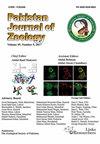Identification of Predictive Factors in Chronic Hepatitis C Patients with Non-Infected Individuals: A Comparative Analysis
IF 0.5
4区 生物学
Q4 ZOOLOGY
引用次数: 0
Abstract
Hepatitis C virus is playing a key role in chronic liver disease all around the globe. Currently, in Pakistan, it is a huge burden on health and the economy, affecting about 6 to 8% of the overall population. HCV is dependent on the lipid metabolism of the patient to replicate and then disturb the blood cell count and liver enzymes to ultimately damage the liver. To distinguish the potential HCV patients from healthy individuals at an early stage is quite important for its control, which can be achieved by investigation of liver enzymes, complete blood count, and lipid profile of patients. In this study, 144 CHC and 20 controls were included. The serum of CHC patients was analyzed for HCV viral load and genotype. The liver function test, lipid profile, sugar levels, and complete blood count values were assessed in the laboratory. Receiver operating characteristics were used to find the biomarkers of infection. Logistic regression analysis revealed that liver enzymes (ALT, AST, ALP, γGT, albumin), blood cell count (globulin, platelets, MCHC RBC, WBC, monocytes% and lymphocytes%), lipid profile (HDL, LDL, VLDL, TC) were significant predictive factors in HCV infection. Similarly, ROC analysis suggested that ALT, AST, ALP, MCHC, TC, and VLDL variables have the potential to discriminate HCV infection from healthy individuals. Biochemical markers like liver enzymes, blood cell count, lipid profile are the main predictive factors of Chronic Hepatitis C patients as compare to the healthy group.慢性丙型肝炎患者与非感染者预测因素的鉴定:一项比较分析
丙型肝炎病毒在全球范围内的慢性肝病中起着关键作用。目前,在巴基斯坦,它是健康和经济的巨大负担,影响到总人口的6%至8%。HCV依赖于患者的脂质代谢进行复制,然后扰乱血细胞计数和肝酶,最终损害肝脏。早期将潜在的HCV患者与健康个体区分开来对于控制HCV非常重要,这可以通过对患者肝酶、全血细胞计数和血脂的调查来实现。本研究纳入144例CHC和20例对照。分析CHC患者血清HCV病毒载量和基因型。在实验室评估肝功能测试、血脂、血糖水平和全血细胞计数值。利用受者操作特征寻找感染的生物标志物。Logistic回归分析显示,肝酶(ALT、AST、ALP、γ - gt、白蛋白)、血细胞计数(球蛋白、血小板、MCHC、红细胞、白细胞、单核细胞%和淋巴细胞%)、血脂(HDL、LDL、VLDL、TC)是HCV感染的显著预测因素。同样,ROC分析表明ALT、AST、ALP、MCHC、TC和VLDL变量具有区分健康人感染HCV的潜力。肝酶、血细胞计数、血脂等生化指标是慢性丙型肝炎患者与健康人比较的主要预测因素。
本文章由计算机程序翻译,如有差异,请以英文原文为准。
求助全文
约1分钟内获得全文
求助全文
来源期刊

Pakistan Journal of Zoology
生物-动物学
CiteScore
1.10
自引率
16.70%
发文量
306
审稿时长
4.5 months
期刊介绍:
Pakistan Journal of Zoology (Pakistan J. Zool.) publishes original articles in English on all aspects of animal life. Generally these articles will be in, or related to one of the following subject areas: Physiology, Cell Biology, Molecular Biology, Genetics, Bioinformatics, Toxicology, Forensic Science, Developmental Biology, Entomology, Parasitology, Microbiology, Biotechnology, Pathology, Palaeontology. Taxonomy, Environmental Biology, Wildlife, Fisheries, Vertebrate and Invertebrate Morphology. Additionally, the journal considers research on health and clinical studies. Short communications are regularly considered, however, uninvited review articles, first records/reports of known species, case reports/studies and survey reports are not published in Pakistan Journal of Zoology.
 求助内容:
求助内容: 应助结果提醒方式:
应助结果提醒方式:


